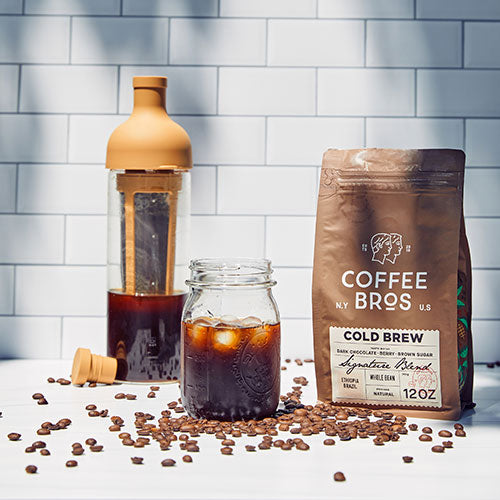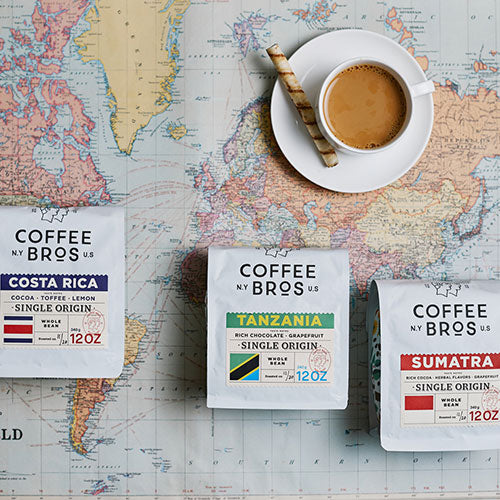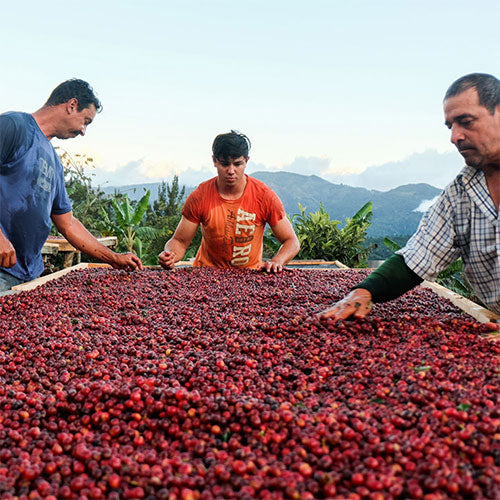December 1st, 2022
How is espresso different from coffee?
Overview
-
What is espresso?
- What coffee roasters want to highlight in their espresso blend
-
What is coffee?
- Auto-drip coffee brew vs. espresso brew
- Does espresso have more caffeine than coffee?
- Why do people drink espresso instead of coffee?
What is espresso?
We’ve encountered this question often as most think that espresso is a specific type of coffee bean and not just a brewing method. We are here to debunk the myth, and with a few caveats, that coffee labeled as espresso is no different from any other coffee you can purchase.
To backtrack on the above statement, coffee specifically labeled espresso means it will work best with the espresso brewing method. The confusion stems from coffee roasters (like ourselves) labeling specific medium-roasted or dark-roasted coffees as espresso to appeal to espresso consumers. The coffee roaster would have specifically sourced and roasted a coffee with the espresso brewing method in mind, which they then label as their Espresso blend or roast. This helps consumers looking for the perfect coffee for their espresso machine home in on a few offerings from a roaster that they know was crafted with espresso making in mind.
While any coffee can be used as espresso, most prefer medium to darker roasted coffee, especially those that make their espresso with milk (think latte or cappuccino) as darker roasted coffees cut through the milk.
What coffee roasters want to highlight in their espresso blend
When crafting an espresso product, they approach taste profiles with a few things in mind.
- How would the coffee taste as an espresso?
- How would the coffee taste as an espresso with milk?
Coffee roasted for espresso without any milk may range from light-medium roasted coffees to dark with varying flavor profiles. A bright, sweet, and fruit-forward espresso may be just the thing your customer is looking for, or they may be looking for something bold, rich, and chocolatey. When thinking of an espresso that will work well with milk, roasters will typically push the roast profile to medium-dark or to very dark for the espresso brew itself to easily cut through the milk.
Next time you see a coffee labeled as “Espresso,” know that it is no different from any other coffee you can purchase but do note that it was roasted with a specific brewing method in mind.
What is coffee?
Coffee is many things; first and foremost, it is a plant (Coffea arabica), and the term “coffee” can encompass brewing methods like pour-over or French press, indicators that define flavor like roast profile (light, medium, or dark), processing method (natural, washed, honeyed), origin, and so much more.
When thinking about coffee, we think of all these things, which is why comparing coffee to espresso is like comparing apples to oranges.
The better question would be to compare the espresso brewing method to the drip brewing method and the comparisons between the two. Since we now know from our previous definition that coffee is espresso and espresso is coffee, we need to get more specific on the differences in roast profile or brewing methods to make proper comparisons.
For most, when they hear coffee, they may think of a 12oz mug of drip coffee, maybe a medium to dark roast, and think how that differs from espresso.
When comparing an auto-drip coffee machine brew to an espresso, we first would compare the following elements.
- The difference in total coffee grounds used
- The difference in total water used
- The brew ratio (which is simply taking the above coffee-to-water ratio)
- The grind size for each brew
- The total time the coffee brewed
- The temperature at the coffee was brewed at
- The final brew weight
Here is what we see on average for these brewing methods. Remember that each element seen below directly impacts the coffee's end taste, which is why some prefer espresso over drip coffee and vice versa (and, of course, many enjoy both!) The below represents the averages for each brew type, and we will pretend we are brewing a 12oz mug of coffee versus a double shot of espresso weighing in at 1.4oz.
| Inputs | Auto-drip Coffee | Espresso |
|
Coffee grounds used |
20 – 22g |
18 – 20g |
|
Total water used |
12oz |
1.4 - 1.5oz |
|
Brew Ratio |
1:13 – 1:15 |
1:1.5 – 1:2 |
|
Grind Size |
Coarse |
Fine |
|
Brew Time |
3:00 – 5:00 minutes |
< 40 seconds |
|
Temperature |
80 – 95 C |
92 – 95 C |
|
Final Brew Weight |
12oz |
1.4 - 1.5oz |
|
Brewing type |
Gravity brewing |
Pressurized brewing |
You will notice a few apparent differences between auto-drip coffee versus espresso, and that comes down to total brew weight and brew time.
Espresso is an extremely fast brewing method that pushes high-pressured water through a “puck” of coffee grounds, producing a robust, flavorful and highly concentrated beverage. This is in stark contrast to an auto-drip coffee, where more water coffee is used, the brew length is much longer, and the clarity of the cup is much higher than that of espresso.
While you can undoubtedly brew any roast color across any brewing method, espresso is often reserved for medium to darker roasted coffees, especially if one intends to add milk to their beverage.
Does espresso have more caffeine than coffee?
There's much misinformation regarding caffeine in black coffee and espresso. Most people assume that espresso drinks are way more potent than regular black coffee… but that assumption is wrong.
Here's why.
A regular double shot of espresso has between 60mg and 100mg of caffeine. That's for ~2 ounces of liquid, so 30-50mg of caffeine per ounce.
Now let's look at regular coffee.
A mug of black coffee typically has between 65mg and 120mg. That's for an 8-ounce cup, so 8-15mg of caffeine per ounce.
When you consider serving size, it's close, with black coffee coming in slightly higher (on average).
But there's more to the story: most people drink more than 8 ounces of black coffee.
So, if you drink 12 ounces, you end up with 100-180mg… which is potentially 2-3x as much caffeine as a double shot of espresso in a latte or cappuccino. And if you go up to 16 ounces of black coffee, the difference is even higher.
Why do people drink espresso instead of coffee?
For the flavor, of course! Espresso is a beautiful, quick, versatile, and flavorful way of getting your daily dose of caffeine. Like any other brewing method, Espresso flavors can range from bright and vibrant to bold and robust. The espresso brewing method creates a highly concentrated beverage with a thick mouthfeel (think crema) that many have become accustomed to enjoying. Now, add some milk to your espresso, and you are looking at many milk-based espresso drinks like lattes, cappuccinos, cortados, and more than any coffee drinker can enjoy.




